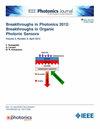Research on Physical Layer Security Performance of Hybrid RF/FSO System Based on RIS Assistance under FSO Eavesdropping Environment
IF 2.1
4区 工程技术
Q3 ENGINEERING, ELECTRICAL & ELECTRONIC
引用次数: 0
Abstract
This paper proposes ahybrid RF/FSO system based on RIS reflection to interfere with eavesdroppers in FSO eavesdropping scenarios, and analyzes and optimizes the physical layer security performance of this communication system. In this work, the RF link experiences Nakagama-m distribution, there is a single-antenna eavesdropper E 1 trying to eavesdrop on the RF link information, and the RIS reflection friendly interference signal is used to interfere with the RF link. The FSO link follows the Málaga (M) distribution. There is a single-antenna passive eavesdropper with optical eavesdropping equipment near the destination node to capture the optical signal sent by the relay and eavesdrop on the information. Based on the above communication model, we derive the Strict Positive Secrecy Capacity (SPSC) and Secure Outage Probability (SOP) under double eavesdropping, and use the Monte Carlo method to verify the correctness of the expressions. The impact of various parameters in the system on safety performance was analyzed. The results showed that the interference signal-to-noise ratio, time switching factor and energy conversion efficiency of the wireless power supply jammer, the increase in the number of RIS reflective elements, good weather conditions and better detection methods, etc. All influencing factors can improve physical layer security performance, which also lays a theoretical foundation for the application of hybrid RF/FSO systems where eavesdropping exists in both RF links and FSO links.FSO 窃听环境下基于 RIS 辅助的 RF/FSO 混合系统物理层安全性能研究
本文提出了一种基于RIS反射的射频/FSO混合系统,用于干扰FSO窃听场景中的窃听者,并对该通信系统的物理层安全性能进行了分析和优化。在这项工作中,射频链路经历 Nakagama-m 分布,存在一个试图窃听射频链路信息的单天线窃听者 E1,利用 RIS 反射友好干扰信号来干扰射频链路。FSO 链路遵循马拉加(M)分布。目的节点附近有一个带光窃听设备的单天线无源窃听器,用于捕捉中继器发送的光信号并窃听信息。基于上述通信模型,我们推导出了双重窃听下的严格正向保密容量(SPSC)和安全中断概率(SOP),并使用蒙特卡罗方法验证了表达式的正确性。分析了系统中各种参数对安全性能的影响。结果表明,干扰信噪比、无线供电干扰器的时间开关因子和能量转换效率、RIS 反射元件数量的增加、良好的天气条件和更好的探测方法等。所有影响因素都能提高物理层安全性能,这也为同时存在射频链路和 FSO 链路窃听的射频/FSO 混合系统的应用奠定了理论基础。
本文章由计算机程序翻译,如有差异,请以英文原文为准。
求助全文
约1分钟内获得全文
求助全文
来源期刊

IEEE Photonics Journal
ENGINEERING, ELECTRICAL & ELECTRONIC-OPTICS
CiteScore
4.50
自引率
8.30%
发文量
489
审稿时长
1.4 months
期刊介绍:
Breakthroughs in the generation of light and in its control and utilization have given rise to the field of Photonics, a rapidly expanding area of science and technology with major technological and economic impact. Photonics integrates quantum electronics and optics to accelerate progress in the generation of novel photon sources and in their utilization in emerging applications at the micro and nano scales spanning from the far-infrared/THz to the x-ray region of the electromagnetic spectrum. IEEE Photonics Journal is an online-only journal dedicated to the rapid disclosure of top-quality peer-reviewed research at the forefront of all areas of photonics. Contributions addressing issues ranging from fundamental understanding to emerging technologies and applications are within the scope of the Journal. The Journal includes topics in: Photon sources from far infrared to X-rays, Photonics materials and engineered photonic structures, Integrated optics and optoelectronic, Ultrafast, attosecond, high field and short wavelength photonics, Biophotonics, including DNA photonics, Nanophotonics, Magnetophotonics, Fundamentals of light propagation and interaction; nonlinear effects, Optical data storage, Fiber optics and optical communications devices, systems, and technologies, Micro Opto Electro Mechanical Systems (MOEMS), Microwave photonics, Optical Sensors.
 求助内容:
求助内容: 应助结果提醒方式:
应助结果提醒方式:


